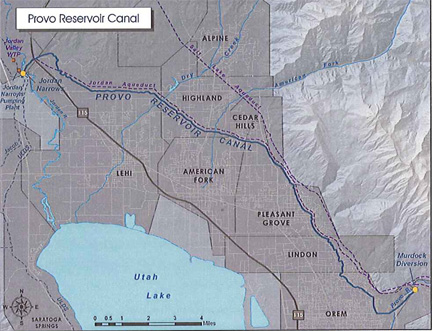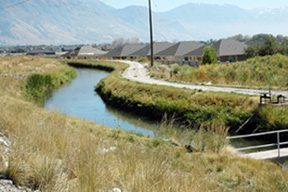Provo Reservoir Canal Enclosure Project
Efforts move forward to install a pipe or box culvert to enclose an open canal that supplies municipal water to SLC's service area.
LeRoy W. Hooton, Jr.
November 24, 2008
|
The PRC is a century old water conveyance facility. Farmers constructed the 22-mile long canal to divert water from the Provo River at the Murdock Diversion works located at the mouth of Provo Canyon for the purpose of conveying irrigation water to farmlands in northern Utah County. The Provo Reservoir Water Users Company (PRWUC) owned and operated the canal with a capacity of 180 cfs. The canal is also known as the Murdock Canal.
In the early thirties, the canal was incorporated into the Provo River Project (PRP) and in the 1940s enlarged to 550 cfs to carry both the PRWUC's water and the water developed by the PRP. Besides the canal and diversion structure, the PRP consists of diversion works from the Weber Basin and Duchesne Basin, Deer Creek Dam and Reservoir, the Jordan Narrows siphon and pumping plant and the South Lateral. The Salt Lake Aqueduct and Terminal Reservoirs were separate components of the PRP, and built solely to supply water to the Metropolitan Water District of Salt Lake City, now to include Sandy City (MWDSLS).
In gaining approval of the PRP, the federal government insisted on one agency to be responsible for the operation and maintenance of the project and insure repayment of the project's reimbursable costs. On May 2, 1935, PRWUA was incorporated. PRWUA has issued 100,000 shares of capital stock based on a annual full allotment of 100,000 acre-feet of water.
Originally MWDSLS subscribed to 46,000 shares, which subsequently was increased to 61,700 shares through additional subscriptions and an exchange agreement with the Utah Lake Distributing Company. The PRWUC subscribed to 16,000 shares and conveyed both their original Provo River water and their new rights acquired in the PRP into the enlarged canal. The Metropolitan Water Districts of Provo, Orem, Lehi, American Fork and Pleasant Grove-Lindon, and Highland Conservation District are the remaining PRP subscribers.
|
Over the intervening years, the canal has provided irrigation water to farmlands in northern Utah and Salt Lake Counties and beginning in the 1990s municipal water to Salt Lake County. Urbanization is anticipated to continue in both counties replacing farmlands and changing the water deliveries from irrigation to municipal supply for hundreds of thousands of residents.
Both the MWDSLS and the Jordan Valley Water Conservancy District (JVWCD) take water from the PRC into treatment plants for municipal use near the Point of the Mountain. JVWCD acquired interest in the canal during the 1990s when they entered into an exchange agreement with the Jacob/Welby Irrigation Company, which owned stock in the PRWUC. This water is treated in the Jordan Valley WTP located in Buffdale. Last year MWDSLS began treating water from the PRC in its new Point of the Mountain WTP located in Draper.
Utah Lake System (ULS) water developed by the Central Utah Water Conservancy District (CUWCD) will also be conveyed in the canal. Construction of a pipeline from the Spanish Fork to PRC is currently underway. Likewise, JVWCD anticipates the need to convey additional water in the canal to serve its growing service area.
Faced with urban growth along the PRC corridor and the need to supply additional municipal water supply, PRWUA decided to install a pipe or box culvert to enclose the canal and restore the original 550 cfs capacity of the PRP. Although the capacity of the Murdock Diversion structure from the Provo River will not be increased, certain reaches of the Project will be increased to as much as 623 cfs to be able to convey the additional water from the ULS and other sources. The Project cost is estimated to be $150 million.
Besides restoring capacity, other benefits of enclosing the canal in a pipe or box culvert are manifold: public safety, improved water quality, improved efficiencies in the operation and maintenance of the canal corridor and saving of seepage and evaporation losses, which provide new water for instream flows in the Provo River. These flows are needed for the June Sucker Recovery Program.
Also, as part of the Project, public space will be made available to the adjoining communities. A trail system will be constructed within the canal corridor allowing non-motorized uses including walking, running, bicycling, equestrian and other non-motorized uses. PRWUA has acquired a federal grant of $11.75 million to help with the trail construction. A partnership of the adjoining cities, Utah County and Mountainland Association of Governments are working with PRWUA to plan and construct the trail and associated facilities.
Currently, negotiations among PRWUA, United States Interior Department, CUWCD, JVWCD, State Division of Water Resources and others are being conducted to complete the necessary agreements. Engineering design of the Project is underway in anticipation of the completion of these various agreements and securing financial arrangements. Denos is optimistic that all of the complex parts associated with the Project will come together soon.

